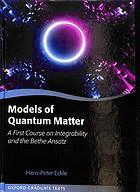Table Of ContentOUPCORRECTEDPROOF – FINAL,11/6/2019,SPi
MODELS OF QUANTUM MATTER
OUPCORRECTEDPROOF – FINAL,11/6/2019,SPi
OUPCORRECTEDPROOF – FINAL,11/6/2019,SPi
Models of Quantum Matter
A First Course on Integrability and the Bethe Ansatz
Hans-Peter Eckle
HumboldtStudyCentre
UlmUniversity
1
OUPCORRECTEDPROOF – FINAL,11/6/2019,SPi
3
GreatClarendonStreet,Oxford,OX26DP,
UnitedKingdom
OxfordUniversityPressisadepartmentoftheUniversityofOxford.
ItfurtherstheUniversity’sobjectiveofexcellenceinresearch,scholarship,
andeducationbypublishingworldwide.Oxfordisaregisteredtrademarkof
OxfordUniversityPressintheUKandincertainothercountries
©Hans-PeterEckle2019
Themoralrightsoftheauthorhavebeenasserted
FirstEditionpublishedin2019
Impression:1
Allrightsreserved.Nopartofthispublicationmaybereproduced,storedin
aretrievalsystem,ortransmitted,inanyformorbyanymeans,withoutthe
priorpermissioninwritingofOxfordUniversityPress,orasexpresslypermitted
bylaw,bylicenceorundertermsagreedwiththeappropriatereprographics
rightsorganization.Enquiriesconcerningreproductionoutsidethescopeofthe
aboveshouldbesenttotheRightsDepartment,OxfordUniversityPress,atthe
addressabove
Youmustnotcirculatethisworkinanyotherform
andyoumustimposethissameconditiononanyacquirer
PublishedintheUnitedStatesofAmericabyOxfordUniversityPress
198MadisonAvenue,NewYork,NY10016,UnitedStatesofAmerica
BritishLibraryCataloguinginPublicationData
Dataavailable
LibraryofCongressControlNumber:2019930263
ISBN978–0–19–967883–9
DOI:10.1093/oso/9780199678839.001.0001
Printedandboundby
CPIGroup(UK)Ltd,Croydon,CR04YY
LinkstothirdpartywebsitesareprovidedbyOxfordingoodfaithand
forinformationonly.Oxforddisclaimsanyresponsibilityforthematerials
containedinanythirdpartywebsitereferencedinthiswork.
OUPCORRECTEDPROOF – FINAL,11/6/2019,SPi
FürIrene
OUPCORRECTEDPROOF – FINAL,11/6/2019,SPi
OUPCORRECTEDPROOF – FINAL,11/6/2019,SPi
Preface
WhystudyBetheansatz?TheBetheansatzprovidesoneoftheveryfewmethodologiesto
calculatethephysicalpropertiesofmodelsforstronglyinteractingquantummatternon–
perturbatively.Arguablyitistheonlysuchmethodwehavewhichisexact.Thismeans,
once we have set up the model, there are no approximations or further assumptions
necessary:wecanexactlycomputephysicallyrelevantpropertiesofthemodel.Thereis,
furthermore,an infinite set of conserved quantities:the quantum mechanical model is
integrable.
Thismakesthesearchforquantummodelswhichareamenabletoanexactsolutionby
theBetheansatzmethodologysoimportantandrewarding.Evenif—asissometimes,but
certainlynotalways,thecase—themodelwithanexactsolutionisnotthemostphysically
relevantone,theexactsolutionwillprovideimportantbenchmarksforothermodelsthat
mayoccasionallybeclosertophysicalreality,butdonotadmitanexactsolution.Hence,
foraplethoraofcases,theBetheansatzsolutionprovidesvaluableinsightintothephysics
ofstronglyinteractingquantummatter.
SinceHansBetheprovidedtheeponymousmethodtosolvetheHeisenbergquantum
spinchain,manymoremodelsoflow-dimensionalquantumsystemshavebeenfoundto
beintegrablebytheBetheansatz.
Moreover,thesemodelsandtheirintegrabilityhavebeenandcontinuetoplayaninflu-
ential role in many subfields of physics,which include classical and quantum statistical
mechanics, quantum field theory, and quantum many-particle and condensed matter
physics,thelatterinrecenttimesespeciallyinconnectionwithmoderndevelopmentsin
physicsonthenanometrescaleandinlowdimensions.Quantumopticshasalsobenefited
from studying integrable models, especially in investigations of ultracold Bosonic and
Fermionic quantum gases and Bose–Einstein condensates in artificial crystals of light,
the so-called optical lattices. Recently in string theory and cosmology there is a hype
of activity involving conjectures of Bethe ansatz integrability in the framework of the
celebratedanti-de-Sitterspace/conformalfieldtheory(AdS/CFT)correspondence.
Ofcourse,BetheansatzandintegrabilityarediscussedinMathematicalPhysics,but
thereisalsoanongoingcross-fertilizationwithvarioussubfieldsofpureMathematics.
Some prominent examples of integrable models include: various variants of the
Heisenberg quantum spin chain whose physical realizations are probed by neutron
scattering; the Hubbard model and its variants which inter alia have been discussed
in connection with high-temperature superconductivity; the Kondo model which has
recently seen a renaissance because of the development of tunable quantum dots;
interactingBoseandFermigaseswhichcannowbeproducedinverypureandtunable
forminopticallattices.
OUPCORRECTEDPROOF – FINAL,11/6/2019,SPi
viii Preface
But,whatistheBetheansatz?Initsoriginalform,devisedbyBethe,itisaningeniously
guessed form for the wave function of a one-dimensional quantum system. However,
whythiswavefunctioniscorrectandevenexactremainedanopenquestionwhichhas
only been answered much later through the algebraic form of the Bethe ansatz. This
method enables us to construct an integrable quantum model in one dimension from
a two-dimensional statistical mechanical model. The construction reveals the reason
for quantum integrability and delivers the infinite set of conserved quantities together
with the wave function which Bethe guessed. In our exposition of the Bethe ansatz
methodology,weshallthereforestart,somewhatunhistorically,butmoresystematically,
withthealgebraicBetheansatz.
Whoisthisbookfor?Interestingly,alookatRichardFeynman’slastblackboards(Paz,
1989)revealsthathemaywellhavebeeninterested.Inoneofhislastpublications(1988),
Feynmaninfactwrote:
‘Igotreallyfascinatedbythese(1+1)-dimensionalmodelsthataresolvedbytheBethe
ansatzandhowmysteriouslytheyjumpoutatyouandworkandyoudon’tknowwhy.I
amtryingtounderstandallthisbetter.’CitedafterBatchelor(2007).
In view of the exciting developments in Bethe ansatz of the last two decades,Richard
Feynman’sfascinationwouldcertainlyhavecontinued.
Themosthelpfulprerequisitesforpresentreadersareagoodgroundinginquantum
mechanics, statistical mechanics, and the basics of quantum many-particle theory,
especiallysecondquantization.However,weshallcomprehensivelydiscussthenecessary
tools and background in part I of the book. Through this approach, the book should
be smoothly accessible for Master’s students who look for an area of specialization as
well as for beginning graduate students.Moreover,to paraphrase Paul Halmos (in the
prefaceofhisbookonMeasureTheory(Halmos,1978)),thenovicetotheBetheansatz
methodologyshouldnotbediscouragedifsheorhefindsthatsheorhedoesnothavethe
prerequisitestoreadthepreliminaries.Afterall,asMaxBornremindsus,wherewould
quantum physics be if Werner Heisenberg had been discouraged that he did not know
whatamatrixwaswhenhedevelopedthematrixformofquantummechanics?
Thebookgrewoutoflecturenotestheauthorpreparedforaninvitedgraduatelecture
series at the Indian Institute of Science in Bangalore in 1995, summer school courses
at the University of Jyväskylä in Central Finland in 1997 (on Bethe Ansatz Methods in
Many–BodyPhysics)and1999(onConformalInvarianceinStatisticalPhysics),agraduate
course at the same University which, together with an amiable group of students,
made the extremely cold Finnish winter of 1999 actually an enjoyable experience,and
postgraduate courses at the University of New South Wales in Sydney in 2000, and
withintheMathematics–PhysicsMP2PlatformatGöteborgUniversityin2009,aswell
assummerschoollecturesinTurkey:2013inTurunç,2014inIzmirand2013inIreland
in Dungarven under the auspices of the School of Theoretical Physics of the Dublin
InstituteforAdvancedStudies.
OUPCORRECTEDPROOF – FINAL,11/6/2019,SPi
Acknowledgements
The author’s working knowledge of the topics and methods on which this book focuses
wasshapedthroughcollaborationswithseveralpeoplewhoaregratefullyacknowledged
in chronological order: Ferenc Woynarovich, Tuong Truong, Chris Hamer, Rudolf
Römer, Bill Sutherland, Alexander Punnoose, Henrik Johannesson, Charles Stafford,
Tim Byrnes, Robert Bursill, Anders Sandvik, and Johan Nilsson. Gratefully acknowl-
edging discussions with many others, especially my thesis advisor Dieter Schotte and
withIngoPeschelandKarolPenson,Ishallnotattempttomentionallofthemforfear
thatsomeone’snamemightescapemyattention.
IlearnedcoordinateBetheansatzfromandduringafruitfulcollaborationwithFerenc
Woynarovich.WebothwereinitiatedtothealgebraicBetheansatzbyTuongTruong.
IalsooftenenjoyedstimulatingdiscussionswithHolgerFrahmaswellasmutualvisits
withFabianEssler,AndreasKlu¨mper,andAndreasSchadschneider.
MydeeplyfeltthanksgotoHenrikJohannessonforhiskindinvitationstoprepareand
deliverlecturesinGöteborgand,veryespecially,forourlong-standingcollaborationand
friendship.
Great thanks are also due to Henrik again and Alexander Stolin for organizing
and co–lecturing the course on ‘Integrable Models and Quantum Groups’ within the
Mathematics–PhysicsMP2 PlatformatGöteborgUniversity.
Jussi Timonen’s initiative is highly appreciated for suggesting and encouraging my
lecturesinJyväskylä.
Valuable discussions with Balazs Hetényi, especially in connection with the co-
organization of the summer schools in Turkey, and with Daniel Braak, are gratefully
acknowledged. Many thanks also go to Karsten Seifert who volunteered to undertake
thealtruistictaskofproof-readingpartsofthisbookatvariousstagesofitsformation.
Many thanks are due to Natan Andrei, Nikolay Bogoliubov, and the late Anatoli
Izergin for their hospitality at Rutgers and in Sankt Petersburg, respectively, and the
sharing of their knowledge in stimulating personal discussions and in the written form
oflecturenotes,andalsotoVladimirKorepinforencouragementonmanyoccasions.
Many thanks are also due to Peter Horsch, Joachim Stolze, and Johannes Voit, and
thelateHeinzBarentzenandHellmutKeiterfordiscussionsandhospitalityinStuttgart,
Bayreuth,andDortmund,respectively,andthesharingofpertinentsetsoflecturenotes.
TheteamatOxfordUniversityPresscannotbepraisedhighlyenough,especiallytheir
friendlypatienceandcheerfulspirit,whichappeartobeinexhaustible.Theincentiveof
April Warman got this project under way and helped it along in its early infant steps.
SönkeAdlungsuppliedfreshguidancetohelptheprojectalongwheneverthereseemed
tobeanimpasse.AniaWronksinevertiredofprovidingmotivationandmomentumfor
thebookprojectand,ofcourse,allthenecessaryinformation.

